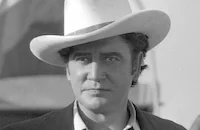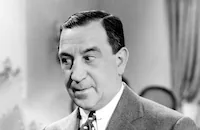The Lost Squadron

Brief Synopsis
Cast & Crew
George Archainbaud
Richard Dix
Mary Astor
Robert Armstrong
Dorothy Jordan
Joel Mccrea
Film Details
Technical Specs

Synopsis
At the end of World War I, aviation aces Captain "Gibby" Gibson, Lieutenant Woody Kerwood, and Red return to America with their mechanic, Fritz, only to discover that their jobs, girl friends and family fortunes have been lost. Years later, Gibby, Red and Fritz, who have become train-hopping hoboes, arrive in Los Angeles and meet up with Woody at the premiere of Sky Heroes , an aviation extravaganza directed by Arthur Von Furst and starring Woody as a daredevil stunt pilot and Follette Marsh, Gibby's former lover, as his romantic interest. After re-establishing their bonds over drinks, Woody convinces his friends to join him in the stunt pilot business and work on Von Furst's next movie. Although Gibby still has strong feelings for Follette, who has married Von Furst to further her acting career, he agrees to fly stunts for the maniacal, jealous director. During shooting, Gibby and Red become rivals for the affections of Woody's sister, who is known affectionally as "The Pest," and eventually she accepts Red's proposal and breaks Gibby's heart. Follette, meanwhile, tries unsuccessfully to dissuade Gibby from flying a last dangerous stunt, convinced that Von Furst will try to kill him if he does. Before Gibby boards the airplane, however, Woody jumps in, unaware that Von Furst has sprayed the control wires with acid. Unable to warn Woody in time, Gibby watches as his friend crashes to his fiery death. Caught with the acid, Von Furst is tied up by Red but later refuses to sign a murder confession. That night, during a struggle, Von Furst tries to flee, but is shot and killed by one of the fliers. After Gibby lies to the police, he deliberately crash-dives his airplane with Von Furst's body in the cockpit, thereby clearing Red of any possible blame.

Director
George Archainbaud
Cast

Richard Dix

Mary Astor

Robert Armstrong

Dorothy Jordan

Joel Mccrea

Erich Von Stroheim

Hugh Herbert

Ralph Ince
Marjorie Peterson
Ralph Lewis

William Davidson
Dick Grace
Art Goebel
Leo Nomis
Frank Clark
Freeman Lang
Crew
James Anderson
Joseph Biroc
Edward Cronjager
George Diskant
Elmer Dyer
Fred Fleck
William Hamilton
Fred Hendrickson
Herman J. Mankiewicz
Hugh Mcdowell Jr.
Humphrey Pearson
Clem Portman
Robert R. Presnell
Max Rée
Max Rée
Robert Robinson
Louis Sarecky
David O. Selznick
Wallace Smith
Leo Tover
Harold Wellman
Harry Wild

Photo Collections
Videos
Movie Clip




Film Details
Technical Specs

Articles
The Lost Squadron
Von Stroheim makes a formidable villain in The Lost Squadron and gives a performance that almost verges on self-parody: that military bearing, the monogrammed megaphones, his crazed and frenzied ordering of people every which way. "Fools! Idiots! Nitwits! ATTENTION! I am speaking now. I don't want to hear another sound. This is a war picture, not a musical comedy." While the Artur von Furst character is a fictitious director, the part could easily have been modeled on von Stroheim's own egotistical behavior on some of his past films. After all, he was billed years earlier by movie magnate Carl Laemmle as "The Man You Love to Hate."
Contrary to popular belief, von Stroheim was not the descendant of a noble Prussian military family, but the son of a Prussian Jewish hatter who had settled in Vienna. And, although he did serve briefly in the Austro-Hungarian army, he was not, as thought by a myth initiated by himself, a career officer in the cavalry. He entered the Hollywood film industry in 1914 and struggled for years playing bit parts that finally gained him recognition for his portrayals of stern and authoritative military men during WWI. However, after the Armistice, his services as an actor were in less demand and he turned to directing where he soon became known for his lavish productions and runaway budgets. Most of all, he was a fiend for perfection. As an example, in his epic melodrama Foolish Wives (1922,) he demanded that the studio build a life-size replica of Monte Carlo and give him money for filming birds in their flying patterns.
After filming his nine hour masterpiece Greed (1925) the studio cut it down to under three hours. This enraged von Stroheim, of course, but it still leaves us with one of the greatest silent films ever made. A few years later, while filming Queen Kelly (1929), von Stroheim became involved in a contentious relationship with star and producer Gloria Swanson and was removed from the picture by the actress before its completion. The film was later released in a heavily cut and reedited version that was not true to von Stroheim's original vision. Yet, his directing career wasn't over; he was assigned his first talkie in 1932 - Walking Down Broadway - but the movie was later shelved and remade by director Alfred Werker as Hello, Sister (1933).
After that, he returned to playing stiff Prussians and decadent aristocrats in both American and European productions. He is, of course, unforgettable as the cultured German commandant in Jean Renoir's Grand Illusion (1937) and equally memorable as Max the manservant in Billy Wilder's Sunset Boulevard (1950). The latter role is particularly fascinating since it so closely mirrors his own career in Hollywood; Once a brilliant director, he is now reduced to working as a butler for his former lead actress. The fact that his co-star Gloria Swanson had worked with him twenty-two years earlier on their ill-fated Queen Kelly only makes the association cruelly ironic.
So while von Stroheim was just starting over again as a character actor in The Lost Squadron, Richard Dix, his co-star, was at the height of his career as a leading man. From 1929 to 1940 he made twenty-six pictures for RKO. The most important of which was Cimarron (1931) which would bring RKO its only Academy Awards for best picture and best screenplay. Though his acting in Cimarron seems rather broad and heavy handed by today's standards, Dix was nominated by the Academy that year for Best Actor. But by the mid-thirties, the studio had relegated him to a steady stream of B-movies and he never regained his star status, eventually dying in 1949 of a heart attack at the age of 55. Yet, at the time he made The Lost Squadron he was as big a box office draw as there was. And he makes a vivid impression as the strong, self-sacrificing lead stunt pilot.
A special mention goes to the fearless stuntmen behind the incredible aerial feats in The Lost Squadron. Daredevil pilot Dick Grace not only wrote the story upon which the screenplay was fashioned, but he was also the lead flier. His fellow stunt men were Art Goebel, Leo Nomis and Frank Clarke. Before computers and graphics manipulation, these men were the real deal. Imagine them showing up at the tiny Wilson airport in Van Nuys, California in the cool of morning, in 1932 to do their scenes. Imagine them as they climb into their aircrafts, which now look like ancient artifacts or boxes with wings - the Waco 10, the Bristol Fighters and others. Then imagine these men as they fly higher and higher into the sky, performing gravity-defying feats while risking their lives for the sake of a motion picture. For once the PR people at the studio were being truthful in their pre-film publicity for the film: "Wingmen of the Hollywood skies courting death.Plunging, zooming, climbing, crashing that a madman below might create on film the supreme thrill to shock the world."
Producer: David O. Selznick
Director: George Archainbaud
Screenplay: Herman J. Mankiewicz, Wallace Smith, Robert R. Presnell, Sr.
Cinematography: Edward J. Cronjager, Elmer Dyer, Leo Tover
Costume Design: Max Ree
Film Editing: William Hamilton
Original Music: Max Steiner
Principal Cast: Richard Dix (Capt. Gibson), Mary Astor (Follette Marsh), Joel McCrea (Red), Erich von Stroheim (Artur von Furst), Dorothy Jordan (The Pest), Robert Armstrong (Lt. Woody Curwood), Hugh Herbert (Fritz), Ralph Ince (Jettick).
BW-80m.
by Joseph D'Onofrio

The Lost Squadron
Quotes
Trivia
The original ending was deemed unclear and unbelievable, so a new ending was shot. As a result, Eric Linden, who was borrowed from Warner Bros. for a small part, was edited out of the film.
Notes
Writer Robert R. Presnell's name was misspelled in the onscreen credits as "Robert S. Presnell." Author Dick Grace was a well-known stunt pilot. It is unclear whether Grace and the other men listed as "fliers" in the cast actually played parts in the film, or were stunt doubles for the principals. Modern sources note that Grace staged several air crashes for the production. David O. Selznick received his first executive producer credit on this film. Freeman Lang, who appears in a scene shot at Grauman's Chinese Theatre in Hollywood, was a radio announcer who emceed broadcasts for movie premieres. RKO inter-department memos indicate that principal shooting on The Lost Squadron was halted so that a new ending could be written. RKO executives, including Selznick, decided that the action of the climax was unclear and unbelievable, and therefore needed to be re-shot. As a result of the new ending, Eric Linden, who had been borrowed from Warner Bros. to play a part, was edited out of the final film. Writer Humphrey Pearson is mentioned in inter-department memos as having received a salary for working with Wallace Smith on the rewrite in some capacity. Although Clem Portman is credited on the film as the sound recorder, all reviews and International Photographer list Hugh McDowell as the soundman, and the film is included in McDowell's, not Portman's, Film Daily Year Book filmography. It is possible that one or the other worked on the re-shoot but not on the original production. Modern sources state that footage from The Lost Squadron was re-used in a 1934 RKO release Lucky Devils (see below). In addition, modern sources note that the following airplanes were used in the production: Nieuport 28, S4C Thomas Morse Scout and biwing Travel Air.














